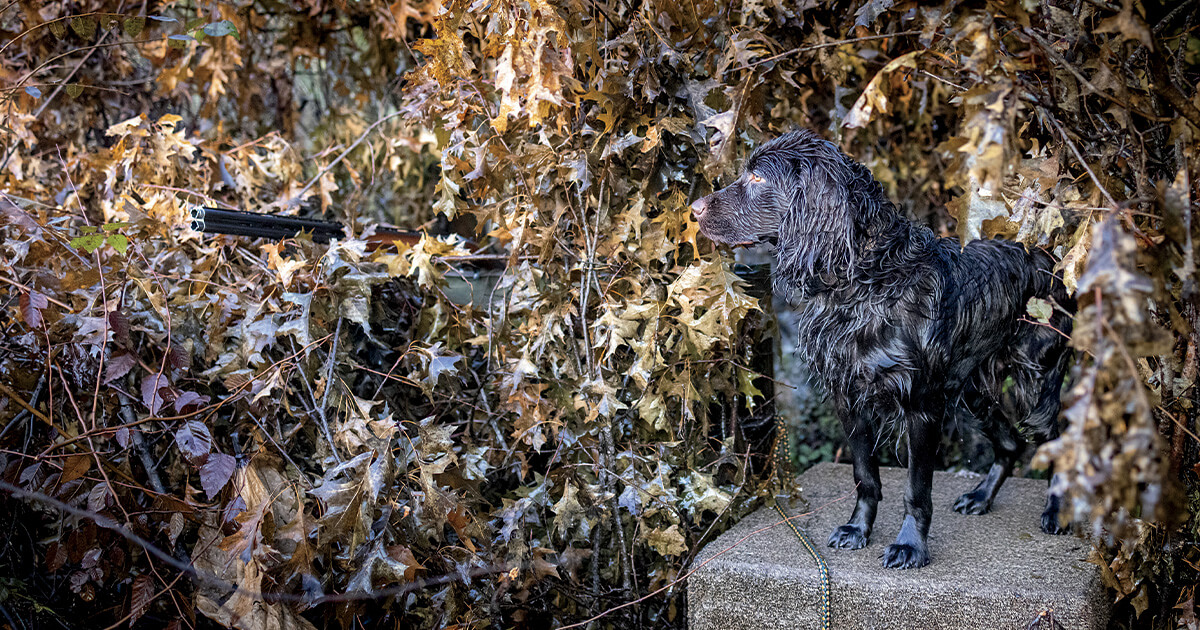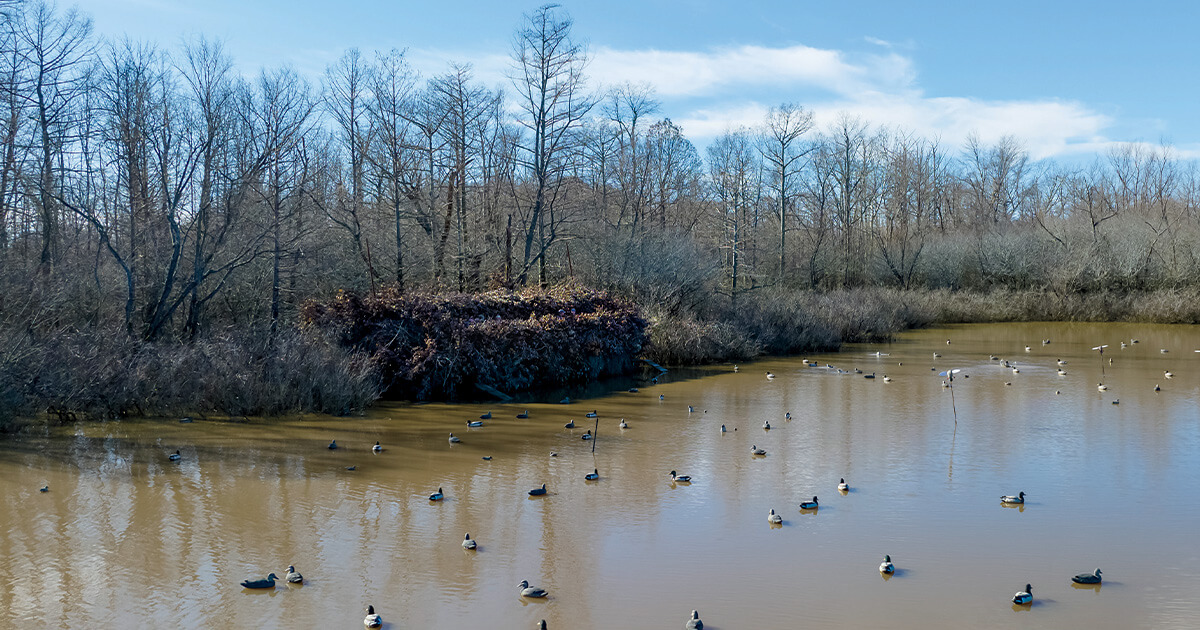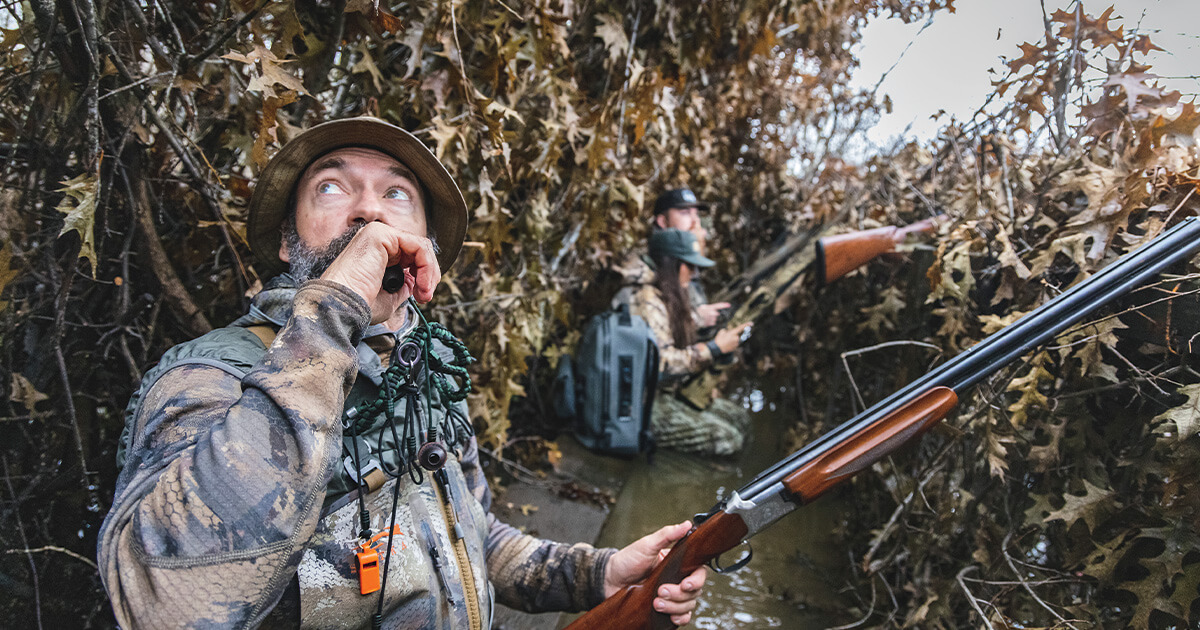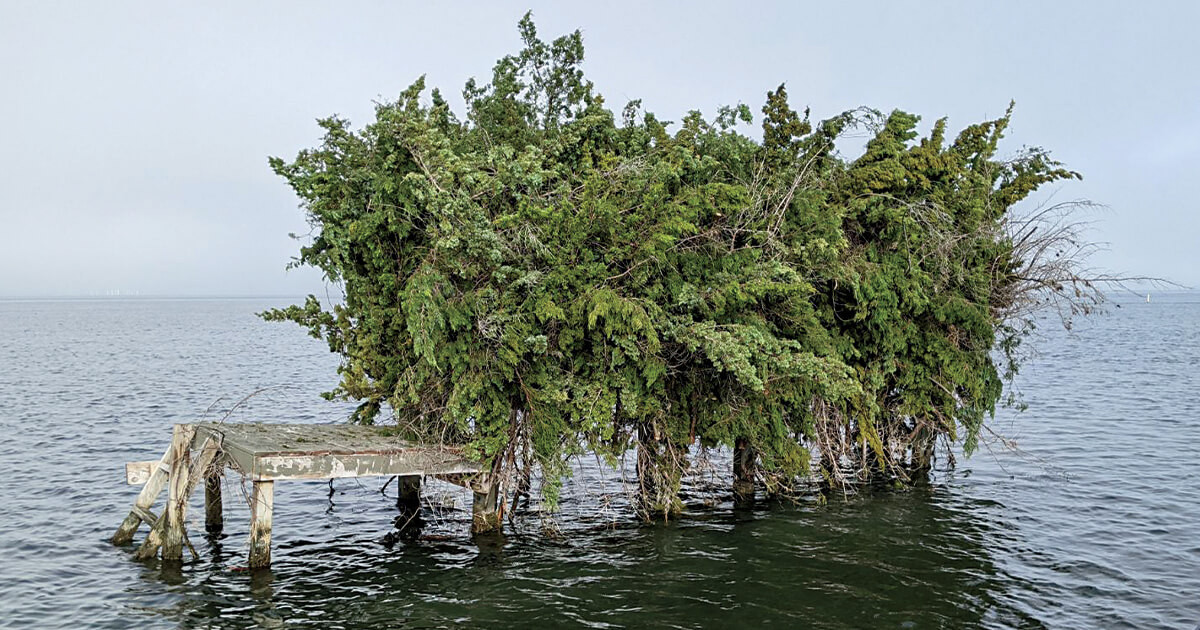Blind Faith
Veteran waterfowlers discuss their favorite blinds and what makes them so effective
Veteran waterfowlers discuss their favorite blinds and what makes them so effective

By Hampton Bourne

For many waterfowlers, blind building and maintenance tops the list of preseason preparations. Regardless of their design and construction, all good blinds must perform their primary role of hiding hunters from the sharp eyes of today’s highly educated birds. Size, comfort, and, in some cases, mobility are also important attributes.
The following expert waterfowlers have identified what they believe are the best blinds for their particular hunting needs and then fine-tuned them to maximize their effectiveness. With any luck, you will be able to use some of their tips to improve your own blind—and improve your hunting success—this season.

Designed for hunting backwater sloughs in western Kentucky, this 10-person floating blind is easy to move when conditions change.
Randy Clouser’s 10-person floating blind is impressive, even in a region known for duck blinds that could easily require building permits. The retired banker hunts a slough in western Kentucky that is naturally flooded by a neighboring creek. Location is essential to concealing such a huge structure. “We move the blind to the shadiest part of the hole so the sun will rise at our backs,” Clouser says. “We also push it back into the trees to keep ducks from landing behind us, and we line up the front of the blind with the surrounding buck brush to blend in.”
Construction
The blind’s footprint is 36 feet by 18 feet. The wood floor is built on top of four-foot-by-four-foot dock floats. It has a raised shooting deck in front and a boat shed in back. To anchor the blind, Clouser uses long metal spud poles mounted on the back. “The blind rises and falls naturally with the water level throughout the season,” he explains. “If we want to move the blind, all we have to do is raise the spud poles and push it. That also makes anchoring the blind a breeze.”
Concealment
Each season, Clouser and his hunting partners attach whole cedar trees to hog wire panels covering the blind. “That gives us a solid base to hang all the rest of our camo,” Clouser says. “We shove oak brush into the cedar trees and hog wire to break up the outline of the blind, and we cover the shooting holes as much as possible. Later in the season, when camo starts running thin, we cut cane and fill in the gaps.”
Creature Comforts
Clouser’s blind has a full kitchen in back and plenty of seating. Some of the shooting holes are equipped with boat seats that swivel so hunters can sit and actively watch for ducks. “We run an electrical line 250 yards back to a generator in the parking area,” Clouser says. “That gives us power to run our lights, ice eaters, and motion decoys.”

Pit blinds come in many shapes and sizes, and outdoor photographer Doug Steinke has tried them all while traveling throughout the Central Flyway. Steinke has also helped construct and install dozens of pits on his home turf along Nebraska’s famed Platte River. “The Platte is full of large sandbars, so you have to get a permit from the Corps of Engineers and a bulldozer to do it right,” he attests. “As with any blind, location is very important. You have to find a spot on the river that is accessible but also where the birds already congregate. The water also has to be shallow enough to put out a decoy spread. Every few years, seasonal flooding changes the profile of the river, and the ‘right spot’ is always moving.”
Construction
Steinke’s pits have a heavy steel frame, and it takes a bulldozer to sink them in the ground. He uses insulated garage door panels for walls and builds a plywood floor on top of the sand. Like many other Platte River pits, the structure isn’t watertight. “Floods are common along the river but they usually only last a day or two. Most people allow water to flow through their pits so they don’t pop out of the ground,” Steinke explains.
Concealment
“Covering shooting holes is the key to concealing pit blinds,” Steinke says. “Open, black holes will spook ducks and geese worse than anything else. We cover shooting holes with sliding lids and use prefabricated grass mats or bundles of natural vegetation for camouflage. We also pack decoys around the edges of the pit to break up the outline.”
Creature Comforts
Adding amenities to a pit blind can be challenging, but Steinke and his hunting partners have all the necessities covered. “It gets bitterly cold during the late season in central Nebraska, so we use small propane heaters in our pits,” Steinke notes. “We also put a Camp Chef portable stove with a griddle in all our blinds. Nothing keeps you warm like a hot breakfast.”

Canadians have perfected dry-field waterfowl hunting, and Alberta resident Brad Fenson claims to be one of the only waterfowlers in the province who owns a pair of waders. His favorite places to hunt are the edges of small potholes surrounded by harvested barley or peas.
After using layout blinds for years, Fenson has recently switched to a mobile stand-up blind. “We have found that ducks and geese in central Alberta are much less wary of one large blind than several layouts,” Fenson says. “I love to hunt areas where you can back the blind into a fencerow or wetland vegetation. We also take the wind into consideration and try to set up in a spot where decoying birds, especially light geese, will come right over the top.”
Construction
“I have a number of portable blinds, but I prefer the ALPS Outdoorz Alpha,” Fenson says. “The blind has an aluminum frame with locking pins that hold it together and can be used to adjust the height. It’s wide enough for a wheelchair, so I can take my 84-year-old dad along on hunts. It also has push-open doors, so you can come up to shoot quickly, and it has dog doors on both ends, which is great for handling retrievers.”
Concealment
Fenson prefers to use natural vegetation to conceal his portable blind. “I’ve tried a lot of different natural camo. For years I used to cut willows, but now I use a handheld trimmer and cut bundles of tall prairie grass,” he says. “You can fold the bundles in half and stuff them into the pockets and loops on the blind. The grass bundles are really durable and look good in almost any habitat. They’ll also last most of the season.”
Creature Comforts
“Adjustable chairs are a must for comfort and safety when you are hunting from a field blind,” Fenson advises. “Several companies make them, and they’re pretty inexpensive. We love the ones that come with adjustable legs so you can adjust the height in the blind. They also swivel and are great on uneven ground.”

Rich-N-Tone Calls President John Stephens regularly hunts ducks and specklebellies on irrigation reservoirs near Stuttgart, Arkansas. “In the early 1900s, there were no laws governing water management. A lot of the bayous and lowland sloughs were dammed to create small reservoirs to irrigate crops,” Stephens explains. “Water is always a concern in Arkansas, especially early in the season, so the reservoirs often attract a lot of birds. We build blinds in the areas that the ducks work naturally and try to build one on both the north and south ends of the hole so we can hunt different winds.”
Construction
The only cover found in many irrigation reservoirs are stands of buck brush, which are often too sparse for hiding a large permanent blind. Stephens has come up with an ingenious solution—using natural cover to conceal hunters.
“First, we look for the tallest buck brush we can find. Then we clear an area 10 feet back in the brush,” Stephens explains. “If there isn’t any brush where we want a blind, we’ll transplant brush from other parts of the hole with a bulldozer when the area is dry. For the front of the blind, we anchor two two-by-fours in concrete on either end and run another two-by-four horizontally between each post to serve as a top rail. We hang hog wire panels on the two-by-fours to form the front of the blind. We also add dirt to the floor to raise it and cover it with gravel for better footing. It’s a wet blind, and we stand in ankle-deep water. The key is using the natural vegetation that is available.”
Concealment
“The blind is the concealment,” Stephens says. “The brush in front of us is the main camo, and overhanging brush conceals us from ducks overhead. We sometimes cut oak brush and willows to form a screen if there isn’t enough natural cover, but most of the time we end up removing cover from inside our blinds instead of adding to it.”
Creature Comforts
“This style of blind is pretty rudimentary,” Stephens says. “There’s water everywhere, so it’s important to keep your gear dry. We build benches and a worktable out of lumber, and we install hooks on the front wall so people can hang their bags and their duck straps. The brush that forms the back wall also offers plenty of space to hang gear.”

Jake Dempsey operates Team Dempsey Guide Service out of Hatteras, North Carolina. Specializing in waterfowling along the famed Outer Banks, Dempsey uses classic “stake blinds” to conceal hunters in open water. “Our blinds are generally a mile to a mile and a half offshore,” Dempsey says. “Ducks winter on the sound around Hatteras, and a lot of divers and pintails rest on the reef. Three feet of water is the perfect depth for a blind, so you can still walk around in a high tide. You need a permit to build a blind, and most have been in the same spot for generations.”
Construction
“Most stake blinds are 5 feet by 10 feet with 4-foot walls,” Dempsey says. “We like the deck to be as close to the water as possible to lower the blind’s profile, but that increases the odds of it washing away during a high tide. Some people build their blinds 10 feet off the water so they have a better chance of surviving storms.”
Concealment
“Traditionally, classic stake blinds were just painted battleship gray with no cover,” Dempsey says. “Old-timers said they blended in with the sky. Some people still do this, but we brush ours with local cedar. It’s a pain because the color fades every year, but if the wind is blowing 50 miles per hour, you don’t lose your cover. Some people use small pine trees, but they can get brittle and fall off by the end of the season.”
Creature Comforts
“We put space heaters in all our blinds. We also bring along a stove so we can cook breakfast,” Dempsey says. “That far offshore, you always have wind, and blocking it is the key to having a comfortable blind. Building a slightly higher back wall with the prevailing wind at your back keeps the conditions from getting miserable.”
Ducks Unlimited uses cookies to enhance your browsing experience, optimize site functionality, analyze traffic, and deliver personalized advertising through third parties. By continuing to use this site, you agree to our use of cookies. View Privacy Policy